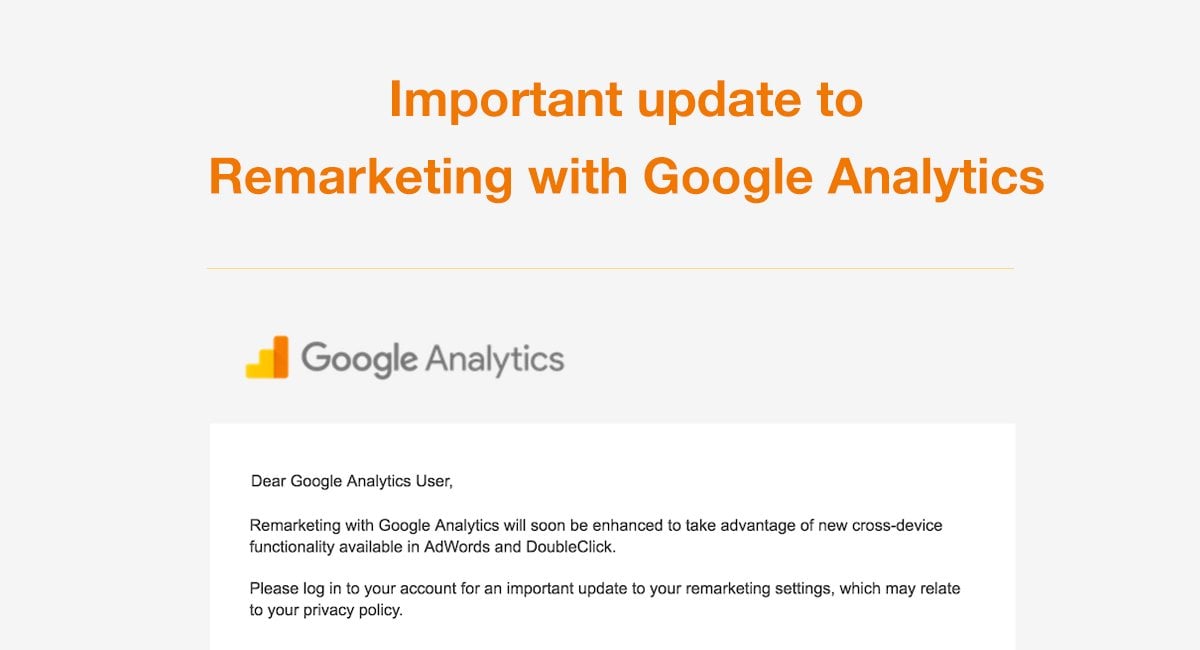Advanced Techniques for Remarketing In Google Analytics
Advanced Techniques for Remarketing In Google Analytics
Blog Article
Maximize Your ROI With Remarketing in Google Analytics
In the world of electronic advertising, the utilization of remarketing techniques within Google Analytics has confirmed to be a potent tool for boosting return on financial investment. By using the power of customer information and tailoring advertisements to specific target market sectors, companies can significantly amplify their conversion rates. The actual essential lies in the art of precision - understanding customer habits, crafting engaging advertisements, and continuously refining techniques to drive ideal results. The journey to making the most of ROI via remarketing is a nuanced course led with insights and chances that can improve the trajectory of your advertising endeavors.
Understanding Remarketing in Google Analytics
Recognizing remarketing in Google Analytics is crucial for enhancing your electronic advertising and marketing strategy. Remarketing enables you to target customers who have actually formerly visited your web site or engaged with your application, providing them with customized ads as they surf other sites or use other applications within the Google Show Network. This technique helps maintain your brand name top of mind and encourages customers to return to your site, ultimately boosting the likelihood of conversion.
By using Google Analytics, you can track the efficiency of your remarketing campaigns, getting important understandings into customer habits, involvement, and conversions. This information enables you to refine your bidding process, messaging, and targeting methods to boost the total effectiveness of your projects.
In addition, understanding the various sorts of remarketing listings available in Google Analytics, such as conventional, vibrant, and comparable target markets, allows you to produce extremely fractional and customized campaigns tailored to specific user sectors. This level of granularity can substantially enhance the relevance and influence of your remarketing efforts, inevitably optimizing your return on investment.
Establishing Remarketing Checklists
To efficiently apply remarketing projects in Google Analytics, the initial step entails producing and setting up remarketing listings targeting certain user sections based on their interactions with your web site or application. By establishing remarketing lists, you can tailor your advertising and marketing initiatives to reach individuals who have already shown interest in your services or products.
To begin, browse to the Admin section of your Google Analytics account and choose the Residential property where you want to develop the remarketing list. Under the Building column, click on 'Target market Definitions' and choose 'Audiences.' Next off, click on the red 'New Target market' switch and choose 'Develop New' to specify the criteria for your remarketing checklist.

Crafting Reliable Remarketing Advertisements

When crafting your ads, emphasis on producing eye-catching headlines and compelling visuals that stand apart to potential customers. Incorporate strong calls-to-action that encourage customers to review your website and complete a desired activity. Make use of dynamic remarketing to reveal individualized ads featuring product and services that customers have actually previously checked out on your website.
Furthermore, ensure that your advertisements are mobile-friendly considering that a substantial see this page section of web traffic originates from mobile tools. Test different ad variants to identify which messages and layouts drive the very best results. By continuously refining and maximizing your remarketing advertisements based on efficiency data, you can maximize their performance and boost your return on investment.
Analyzing Remarketing Efficiency

Through Google Analytics, marketing experts can track the performance of their remarketing projects in real-time, enabling them to determine trends, patterns, and locations for improvement without delay. By analyzing the data, online marketers can figure out which advertisements are carrying out well, which target market sectors are responding positively, and which networks are driving one of the most conversions. This degree of granularity makes it possible for marketing experts to make data-driven decisions to optimize their remarketing campaigns for much better outcomes.
Maximizing ROI With Remarketing
Examining remarketing information in Google Analytics allows marketers to identify chances for enhancing return on investment (ROI) through strategic adjustments - What Is “Remarketing” In Google Analytics?. To optimize ROI with remarketing, it is crucial to understand the habits of your target market. By evaluating user communications, such as the pages they visited, the products they saw, or the actions they handled your site, you can tailor your remarketing campaigns better
Segmenting your audience based on their actions enables you to produce customized and targeted advertisements that are most likely to resonate with them. By revealing appropriate advertisements to particular segments of your audience, you can raise the chances of conversion and inevitably boost your ROI.
Furthermore, checking different advertisement creatives, messaging, and deals can help recognize what resonates ideal with your audience. A/B testing enables you to explore various elements of your ads to establish you could check here what drives the highest possible interaction and conversion rates.
Verdict
To conclude, maximizing ROI with remarketing in Google Analytics calls for a calculated method to analyzing individual actions, segmenting target markets, developing tailored ads, and optimizing campaign my blog performance. By leveraging data-driven insights and examining various methods, services can improve their remarketing initiatives to drive greater interaction and conversion rates. This systematic technique makes certain that resources are successfully allocated towards optimizing rois in remarketing campaigns.
Next, click on the red 'New Target market' button and pick 'Produce New' to specify the criteria for your remarketing listing.
By continuously refining and maximizing your remarketing ads based on efficiency information, you can optimize their efficiency and boost your return on investment.
By delving into these insights, online marketers can obtain an extensive understanding of exactly how their remarketing initiatives are resonating with their target audience and driving conversions. To maximize ROI with remarketing, it is essential to understand the behavior of your audience.In conclusion, maximizing ROI with remarketing in Google Analytics calls for a tactical technique to examining individual behavior, segmenting target markets, producing customized advertisements, and optimizing project efficiency.
Report this page